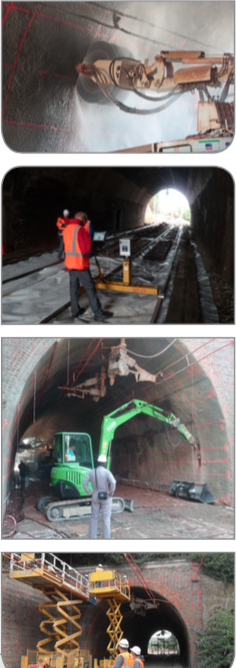 Tunnel Enlargement and Strengthening
Tunnel Enlargement and Strengthening
Client
SNCF
Principal Contractor
Freyssinet
Works Commenced
June 2011
Works Completed
August 2011
PDF Download
Harfleur Tunnel is located on the Paris to Le Havre line in Northern France between Harfleur and Havre-Granville Stations. It is 48m long, 8m wide, 6m high and curved on a 1200mm radius. Two personnel protection refuges exist on each side.
The brick lining of 900mm thickness was showing its age with various defects evident:
1 Erosion of lower side wall bricks by up to 80mm.
2 Detachment of rings of bricks inherent in stretcher bond brickwork and evidenced by hollow sounding under hammer tap testing.
3 Impact damage from rolling stock
Freyssinet was awarded the contract to strengthen the brickwork and spray the entire tunnel with a minimum of 80mm thick concrete. This was to eradicate all areas of exposed brickwork in the tunnel in order to permanently eliminate the risks associated with falling brick panels.
A rail possession of seven weeks was granted because several structures on this route were upgraded at the same time. A track-mounted laser was manually wheeled through the tunnel to measure the position of the surface of the brickwork to ensure there was enough space to provide the concrete lining without fouling the dynamic envelope of future rolling stock. Where space was insufficient, predominantly the haunches, data was recorded to show how much cut-back was required.
Preparatory works included protection of the track to allow access by road vehicles and protection of the catenary. Only then could Freyssinet commence the sandblasting of the complete tunnel walls and crown to remove all unstable surface material.
Where layers of stretcher bond brickwork had become detached from the tunnel wall, stainless steel pins 350mm long and made from 8mm wide twisted strip were driven by rotary percussion into 6mm diameter holes pre-drilled into the tunnel wall. This “Torsinox” system doesn’t require resin fixing of the pins as they are such a tight fit. The pins were spaced 1000mm vertically and 660mm horizontally.
The sprayed concrete lining needed to be reinforced with welded steel mesh reinforcement. To hold this securely in place during the spraying, 16mm diameter L-shaped reinforcing bars were embedded 450mm into the side walls and secured with resin.
The widening of the tunnel at the haunches had the potential to seriously weaken the structure, so the work was sequenced to allow construction of reinforced concrete ribs at 2.5m centres followed by removal of the brickwork panels between the ribs. Freyssinet cut the 350-500mm deep recesses for the ribs with a 1200mm diameter diamond saw, arm-mounted on a vehicle. Run-off water from the sawing operation was collected, de-silted and cleaned before disposal. The brickwork was broken out using a pecker on a mini-excavator, the reinforcement cage was inserted and the rib was concreted by spraying to a depth of 350mm.
Once the rib concrete had cured, the brickwork panels between the ribs could be broken out on a hit and miss basis. Brickwork was broken back sufficiently far that at least 80mm of concrete could be applied without fouling the dynamic envelope. The precut mesh sheets were fixed to the wall and the concrete sprayed on. All sprayed concrete was delivered using the dry process where the pre-mixed but dry concrete constituents (cement, sand and small aggregate) are fed to the nozzle by hose before being mixed with water at the point of spraying. It tends to give higher quality and greater strength than the wet mix alternative.
Complementary works included brick stabilisation with stainless steel pins to the tunnel entrance wing walls, after which 100mm thick sprayed concrete was applied again with reinforcing mesh.
